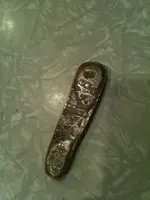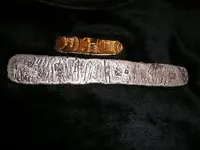This is my first post to the forum.
I found an object that I am just not sure about.
These are a couple of pictures of a metal object I found over the weekend in low mountains of northern Utah. We were metal detecting in Cache county and this was buried about 2 feet deep. It is about 4 oz. in weight and 3.5 inches long. It is quite heavy and is mostly gold in color with copper hues.
The picture does not do a great job capturing the color, as it was dark when we got back and I took the picture on my iphone.
I will try and get some better pictures today or tomorrow. I am not sure what it is made of, or what it is. I am also unsure of what the marks are. Could it be something from the pioneers?
Thanks for your help.
I found an object that I am just not sure about.
These are a couple of pictures of a metal object I found over the weekend in low mountains of northern Utah. We were metal detecting in Cache county and this was buried about 2 feet deep. It is about 4 oz. in weight and 3.5 inches long. It is quite heavy and is mostly gold in color with copper hues.
The picture does not do a great job capturing the color, as it was dark when we got back and I took the picture on my iphone.
I will try and get some better pictures today or tomorrow. I am not sure what it is made of, or what it is. I am also unsure of what the marks are. Could it be something from the pioneers?
Thanks for your help.









![coronadomap[1].webp](/data/attachments/393/393198-a7110bb82afaf906d91b718bd384601c.jpg?hash=UEISpOGTvU)
![routes_texas_explorersmed[1].webp](/data/attachments/393/393208-1ec5dda959f9b9499b70eefe3562f91b.jpg?hash=pFD3oU-UFu)

